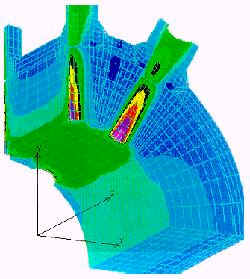|
High Temperature Headers.
Steam headers (i.e. nodes where many large diameter,
steam-carrying pipes converge) are regarded as critical components because they are
subject to large variations in temperature and pressure. They are also extremely expensive
and difficult to replace .
Boiler headers are built to many different designs. However
in general they involve butt and end cap welds between thick section pipes as well as
branch and stub welds. Experience shows that creep damage generally occurs first in the
vicinity of these weldments.
Cracks may also be formed in the parent material ligaments
between stub penetrations as a result of creep fatigue interactions generated by thermal
stresses. In addition to these observed damage modes headers are accumulating microscopic
or sub-microscopic creep damage throughout operation which has to be assessed if the
component is to be used beyond its original design life.
In general, steady state relaxed stresses are at a maximum
at outer surfaces of cylindrical pressure vessels so that access is not a major problem.
Direct observation, replication and material sampling are then options for
damage
assessment by microstructural techniques. There're also techniques for removing samples
for accelerated creep testing without compromising the integrity of the component .
However, the critical region is not always accessible. For example damage in welds
generally initiates sub-surface due to microstructural variations and the position
of maximum stress at stub penetrations is at the bore. In these cases stress analysis,
service experience and ultrasonic examination become the primary assessment tools.

|



